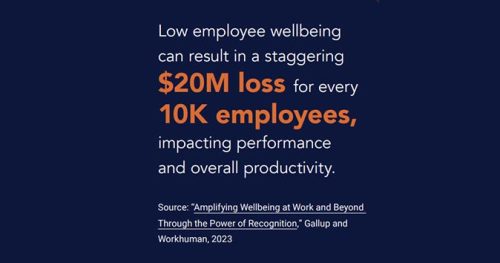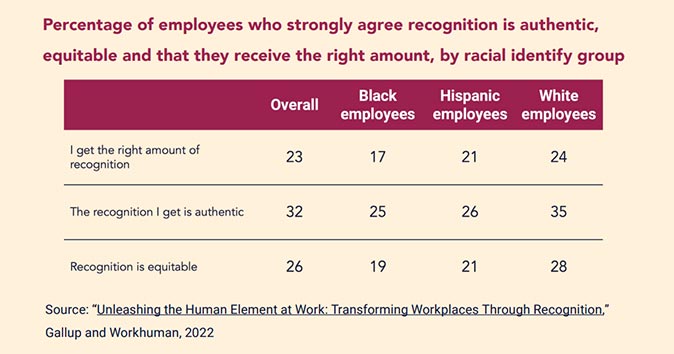Understanding Racism in the Workplace and Its Far-Reaching Effects

Despite 97% of HR leaders reporting that their organization has made changes to improve diversity, equity, and inclusion (DEI), only 37% of employees agree. That gap leaves plenty of room for improvement across all the categories DEI spans.
Today, we’ll take a closer look at one deep and sensitive topic: racism.
We’ll talk about what racism in the workplace is, how it negatively affects your employees and the actions your organization can take to create an anti-racist environment.
What is racism in the workplace?
Racism in the workplace is when an employee is discriminated against due to their race or the color of their skin. Racial harassment is systematic and woven into the structure of organizations across the U.S. Undoing the effects will take significant change by employers and employees.
Data shows how pervasive racism is in our workplaces. Research done by Coqual found that 55% of Black professionals, 43% of Latino professionals, and 36% of Asian professionals have experienced racial prejudice at work.
Research also shows how likely you are to be unaware of how bad it is unless you’ve experienced racial harassment firsthand. According to SHRM research, 49% of Black HR professionals feel that discrimination based on race or ethnicity exists in their workplace, while only 13% of white HR professionals agree.
This gap in perception is a huge problem and just one indicator of how important tackling racism in your workplace is.
Examples of racial discrimination at work
Racist behavior at work ranges from intensely direct to a difficult-to-describe feeling of being perceived differently. Racial discrimination and harassment will look, feel, and sound different from person to person and depending on what racial group you belong to.
For example, Asian employees are more likely to experience perpetual foreigner microaggressions, such as assuming they aren’t from the U.S. or that English isn’t their first language, more than Black or White employees.
Direct discrimination, also known as overt racism, is the easiest to see. It includes racial slurs or jokes, threats, and displaying racist objects or flags.
Indirect discrimination, or subtle racism, includes microaggressions, stereotypical comments or statements, being passed or looked over for promotions or advancement opportunities, judgment on certain hairstyles, hair texture, or headwear, and being treated unfairly after coming forward with a harassment complaint.
A respondent from Workhuman's® survey with BLK Men in Tech explained the impact of indirect discrimination, “When you walk into a corporate environment, all of the preconceived stereotypes are already placed on you as a Black professional.”
Systemic racism, also known as institutional racism, is when there are systems set in place that hold back groups or a certain race. It includes a lack of advancement opportunities, bans on certain hairstyles or headwear, and being outright denied for promotions.
How does racial discrimination influence the workplace?
Racial discrimination influences the workplace by creating an overwhelmingly negative experience for workers. Employees who experience racial discrimination will feel excluded and suffer from reduced well-being, engagement, and productivity.

Research has shown that the human brain processes exclusion similarly to the way it processes physical pain. Experiencing this day in and day out in a workplace compounds the negative impact.
In Workhuman's survey with BLK Men in Tech, 36% of respondents reported their mental health suffered as a result of racial discrimination either in the past or to this day. To protect themselves, employees might act a certain way that doesn’t allow them to bring their whole selves to work.
Doyin Richards, creator of the Anti-Racism Fight Club, has said, “The amount of things that I have to do under the guise of making white people feel comfortable is just soul-destroying.”
Reduced well-being leaves employees who have been racially discriminated, exhausted, at risk for burnout, and looking for new job opportunities.
Women of color who are experiencing intersectional discrimination might feel they have no option but to back out of the workforce. People of color will often experience a lack of advancement opportunities which further increases gaps in pay equity and people of color in leadership roles.
A lack of non-White people in leadership roles leaves younger employees with a lack of role models and mentors. Nearly half (44%) of White professionals have a role model at their current company, while only 29% of Asian professionals feel the same way.
The negative impact of racism in the workplace is cyclical and damaging. A hostile environment perpetuates these behaviors and erases progress toward racial equity.
Let’s talk about how organizations can begin breaking the cycle.
Strategies for tackling racism in the workplace
There is no quick or one-size-fits-all plan for dismantling racism in your workplace. However, there are certain things that your organization has full control over – start with these strategies to create an anti-racist workplace.
Acknowledge that change is necessary
Richards said, “Racism is not something that you can just talk about in nice forms, like, we really need to hit you over the head. You need to see stuff. You need to see what it looks like. And then you'll get moved to be like, ‘Oh, my gosh, we have a real problem here.’”
Leaders need to accept the reality of the situation and understand where the issues are coming from to change unacceptable behaviors. This will be uncomfortable, but it is a necessary step. From here, leadership and HR can begin making a plan for their DEI efforts.
Create a psychologically safe environment
In short, psychological safety can be explained as the feeling of being able to speak your truth without fear. It shouldn’t be a surprise that our research found that White employees experience the highest levels of psychological safety.
Further reading: How to build psychological safety
Employers can build psychological safety by creating welcoming places for employees to share what’s on their minds. This might look like establishing employee and manager weekly check-ins. Workhuman research found that psychological safety is highest for employees who check in with their manager at least once per week and lower for those who check in less frequently.
Collecting employee feedback in company-wide surveys on a regular basis – and acting on it – can also create safety around open dialogue. Consider creating messaging channels that can provide a welcoming space for employees to talk about racist behaviors or incidents.
It’s also important to call out that as it relates to a sensitive structural issue like racism, what you might need is a leader to exhibit psychological bravery in bringing up incidents or problems. This is especially true if employees of color are not in positions of leadership and may fear retaliation for speaking up.
Establish and share clear policies
It shouldn’t be a question of whether your organization tolerates racial discrimination or harassment. Clearly state your guidelines in your employee handbook and on your website. Make this material easy to find, and regularly share it with your employees, vendors, and clients.
Show appreciation by saying thanks
Workhuman and Gallup research has found that giving recognition can help reduce burnout and retain racial and ethnic diversity in organizations. Both Black and Hispanic employees who strongly agree that they are receiving the right amount of recognition are 43% and 44% less likely to be burned out, respectively, than those who do not strongly agree.

In regards to retaining diversity in your organization, Black and Hispanic employees who strongly agree they receive fulfilling recognition are 26% less likely to be actively searching or watching for another job compared to those who do not strongly agree.
In practice, this looks like recognizing employees authentically and frequently. Talk to your managers about tracking both big and small successes. Get to know your coworkers and recognize them for their unique talents, passions, and perspectives.
Offer anti-discrimination and anti-harassment training
Similar to acknowledging the problems in your organization, White workers or other unaffected employees will find attending these sessions uncomfortable. That’s a good sign that true change will come out of the sessions.
Also, recognize that these offerings could be triggering for groups that have experienced discrimination or racism. While attending these sessions might feel affirming for discriminated individuals, know that attendance should always be optional. Doyin Richards has said, “The one thing that I would say when it comes to Black people or people of color in these workshops, it should not be mandatory for them.”
Further reading: DEI training: what it is, what it does, and why your organization needs it
Ensure HR is prepared to handle complaints
Even in a psychologically safe workplace, it takes immense courage for an employee to open up about racist behavior they have experienced or witnessed. Make sure that your HR team is treating each complaint with confidence and respect and each employee with empathy and compassion. This includes doing everything in their efforts to ensure that their complaint does not lead to further racial harassment or discrimination.
Handling formal complaints includes holding employees accountable. You cannot control your employee’s actions, but you can enforce real consequences for racist behaviors. Take prompt and remedial disciplinary action when a formal complaint is made.
Further reading: How to promote diversity, equity, and inclusion in the workplace
Conclusion
Fighting racism in the workplace is challenging and complex. It will take consistent effort, patience, and understanding to create positive change. But we hope you see there is no option but to stick with it. Your employees will feel happier and safer, and society and your business will be more equitable because of it.
About the author
Alicyn Zall
Alicyn Zall is a writer dedicated to creating a more equitable and fulfilling workplace. With a focus on actionable, data-driven insights, her work empowers individuals and organizations to foster positive change. In addition to her contribution at Workhuman, Alicyn has served as an editor at Harvard Business Review where she developed books and articles about mental health and the future of work.